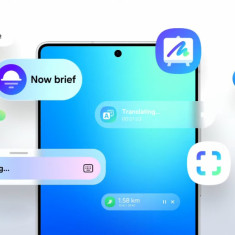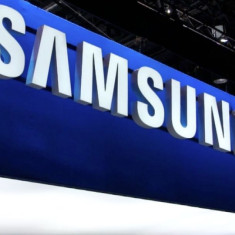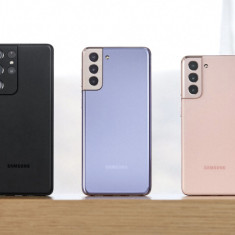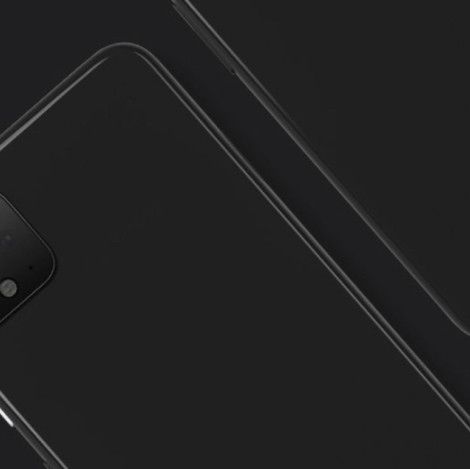Ostatnie newsy
 Kilka tygodni temu publikowaliśmy newsa na temat nowinek z targów Computex Taipei. Jednym z prezentowanych urządzeń był nowy palmtopo-telefon Samsunga z mobilnymi okienkami na pokładzie - modem SPH-M7000, przypominający bardzo urządzenie T-Mobile SideKick. Więcej zdjęć tego intrygującego PDA opublikowano kilka dni temu na witrynie PhoneMag.
Kilka tygodni temu publikowaliśmy newsa na temat nowinek z targów Computex Taipei. Jednym z prezentowanych urządzeń był nowy palmtopo-telefon Samsunga z mobilnymi okienkami na pokładzie - modem SPH-M7000, przypominający bardzo urządzenie T-Mobile SideKick. Więcej zdjęć tego intrygującego PDA opublikowano kilka dni temu na witrynie PhoneMag.  Samsung opracował nową technologię wytwarzania pamięci flash, która pozwoli na upakowanie do 8GB na jednym układzie pamięci flash. Dzięki temu uzyskamy dalszą miniaturyzację kart pamięci oraz osiągniemy większą pojemność dostępnądla użytkownika, w obecnie produkowanych mobilnych nośnikach danych. Ponadto firma Seagate'e poinformowała o zakończeniu prac nad jednocalowym przenośnym dyskiem MicroDrive o tej samej pojemności co karty flash Samsunga. Komunikować się on może z urządzeniami za pośrednictwem interfejsu CompactFlash lub ATA Flex.
Samsung opracował nową technologię wytwarzania pamięci flash, która pozwoli na upakowanie do 8GB na jednym układzie pamięci flash. Dzięki temu uzyskamy dalszą miniaturyzację kart pamięci oraz osiągniemy większą pojemność dostępnądla użytkownika, w obecnie produkowanych mobilnych nośnikach danych. Ponadto firma Seagate'e poinformowała o zakończeniu prac nad jednocalowym przenośnym dyskiem MicroDrive o tej samej pojemności co karty flash Samsunga. Komunikować się on może z urządzeniami za pośrednictwem interfejsu CompactFlash lub ATA Flex.  Na rozpoczętych kilka dni temu targach EXPO COMM Wireless Korea 2005 producenci urządzeń mobilnych zaprezentowali kilka ciekawych projektów. Jednym z nich jest nowy palmtopo-telefon Samsunga, który na pierwszy rzut oka przypomina urządzenie T-Mobile SideKick, znane także jako Danger HipTop. Projekt obudowy aparatu SPH-M7000, z zintegrowaną wysuwaną klawiaturą QWERTY (a raczej wysuwanym ekranem, w stosunku do reszty PDA) faktycznie jest jakby "na licencji" SideKicka.
Na rozpoczętych kilka dni temu targach EXPO COMM Wireless Korea 2005 producenci urządzeń mobilnych zaprezentowali kilka ciekawych projektów. Jednym z nich jest nowy palmtopo-telefon Samsunga, który na pierwszy rzut oka przypomina urządzenie T-Mobile SideKick, znane także jako Danger HipTop. Projekt obudowy aparatu SPH-M7000, z zintegrowaną wysuwaną klawiaturą QWERTY (a raczej wysuwanym ekranem, w stosunku do reszty PDA) faktycznie jest jakby "na licencji" SideKicka.  Jak zapewne kojarzycie Samsung SGH-i300, znany także pod nazwą Thor, to pierwszy aparat z systemem z rodziny MS Smartphone, który wyposażony zostanie we wbudowany dysk twardy. Poza tym będzie on oferował również okienka WM 2003 Second Edition oraz ekran hi-res, czyli 320x240 punktów. Niestety data premiery tego urządzenia oraz jego cena nadal stanowi tajemnicę. W oczekiwaniu na ów aparat zapraszamy do zapoznania się ze sporą galerią zdjęć tego telefonu opublikowaną na witrynie the::unwired. Szczegóły techniczne tego urządzenia dostępne są w poprzednich newsach jemu poświęconych.
Jak zapewne kojarzycie Samsung SGH-i300, znany także pod nazwą Thor, to pierwszy aparat z systemem z rodziny MS Smartphone, który wyposażony zostanie we wbudowany dysk twardy. Poza tym będzie on oferował również okienka WM 2003 Second Edition oraz ekran hi-res, czyli 320x240 punktów. Niestety data premiery tego urządzenia oraz jego cena nadal stanowi tajemnicę. W oczekiwaniu na ów aparat zapraszamy do zapoznania się ze sporą galerią zdjęć tego telefonu opublikowaną na witrynie the::unwired. Szczegóły techniczne tego urządzenia dostępne są w poprzednich newsach jemu poświęconych.  Ponad miesiąc temu podawaliśmy informację na temat pierwszego aparatu Samsunga, w którym zainstalowano system Nokia Series 60 II. Galerię interesujących CEBITowych fotografii tego telefonu, znanego jako SGH-D720 znajdziecie w jednym z wczorajszych newsów, opublikowanycn na witrynie Telefon.pl. Cynk nadesłał xero_boy
Ponad miesiąc temu podawaliśmy informację na temat pierwszego aparatu Samsunga, w którym zainstalowano system Nokia Series 60 II. Galerię interesujących CEBITowych fotografii tego telefonu, znanego jako SGH-D720 znajdziecie w jednym z wczorajszych newsów, opublikowanycn na witrynie Telefon.pl. Cynk nadesłał xero_boy  Firma Samsung jest ostatnio bardzo płodna jeśli chodzi o wytwarzanie palmtopo-telefonów z okienkami Microsoftu na pokładzie. Tym razem prezentujemy kolejne urządzenie oznaczone symbolem SPH-M4300, bardzo podobne z wyglądu do poprzednio ujawnionych modeli. Szczegółowe dane techniczne tego aparatu nie są jeszcze znane, ale wygląda na to że bedzię to urządzenie skierowane dla mobilnych audiofili. Wyposażone będzie bowiem w wysokiej jakości układ dźwiękowy i dwa głośniki pracujące w trybie SRS. Ponadto ma on posiadać procesor Intel X-Scale PXA272 520MHz, aparat cyfrowy o matrycy 1.3Mpix, 2.8" ekran oraz moduł WLAN. Rozmiary SPH-M4300 będą następujące: 114 mm x 59 mm x 25 mm.
Firma Samsung jest ostatnio bardzo płodna jeśli chodzi o wytwarzanie palmtopo-telefonów z okienkami Microsoftu na pokładzie. Tym razem prezentujemy kolejne urządzenie oznaczone symbolem SPH-M4300, bardzo podobne z wyglądu do poprzednio ujawnionych modeli. Szczegółowe dane techniczne tego aparatu nie są jeszcze znane, ale wygląda na to że bedzię to urządzenie skierowane dla mobilnych audiofili. Wyposażone będzie bowiem w wysokiej jakości układ dźwiękowy i dwa głośniki pracujące w trybie SRS. Ponadto ma on posiadać procesor Intel X-Scale PXA272 520MHz, aparat cyfrowy o matrycy 1.3Mpix, 2.8" ekran oraz moduł WLAN. Rozmiary SPH-M4300 będą następujące: 114 mm x 59 mm x 25 mm.
Technologia bezprzewodowej transmisji danych Wi-Max będzie miała konkurenta. Samsung ogłosił bowiem powstanie nowego standardu o nazwie Wi-Bro (skrót ten pochodzi o słów Wireless Broadband). Technologia ta pracować będzie na falach 2.4GHz i oferować transfer na poziomie 50Mbps. Dostęp do szybkiego internetu będziemy mieli nawet z samochodu poruszającego się z prędkością do 60km na godzinę. Pierwsze komercyjne sieci Wi-Bro mają zostać uruchomione w czerwcu 2006 roku w Korei, choć Samsung rozpoczął już pierwsze testy także na nowym kontynencie.
 Aparat o kodowej nazwie B-Bop to drugie z prototypowych urządzeń Samsunga jakie prezentowaliśmy na początku stycznia tego roku. Na targach CEBIT pokazano ostateczną już edycję tego urządzenia, pracującego pod telefoniczną edycją okienek Windows Mobile 2003 SE for Pocket PC. Samung ten nosi teraz nazwę SGH-i750 i posiada trójzakresowy moduł GSM/GPRS/EDGE, 128MB pamięci ROM, 64MB RAM oraz 2.8" ekran o rozdzielczości 320x240 punktów, wyświetlający 65 tysięcy kolorów. Ponadto pod jego maską znajduje się moduł Bluetooth oraz WLAN, a także gniazdo na karty pamięci w standardzie TransFlash. Jest też aparat cyfrowy o matrycy 2Mpix. W urządzeniu SGH-i750 nie zabraknie popularnej w nowych produktach Samsunga zintegrowanej klawiatury - tym razem alfanumerycznej, wysuwanej od spodu z tylnej ściany PDA. Sercem aparatu będzie prawdopodobnie procesor taktowany zegarem 400MHz.
Aparat o kodowej nazwie B-Bop to drugie z prototypowych urządzeń Samsunga jakie prezentowaliśmy na początku stycznia tego roku. Na targach CEBIT pokazano ostateczną już edycję tego urządzenia, pracującego pod telefoniczną edycją okienek Windows Mobile 2003 SE for Pocket PC. Samung ten nosi teraz nazwę SGH-i750 i posiada trójzakresowy moduł GSM/GPRS/EDGE, 128MB pamięci ROM, 64MB RAM oraz 2.8" ekran o rozdzielczości 320x240 punktów, wyświetlający 65 tysięcy kolorów. Ponadto pod jego maską znajduje się moduł Bluetooth oraz WLAN, a także gniazdo na karty pamięci w standardzie TransFlash. Jest też aparat cyfrowy o matrycy 2Mpix. W urządzeniu SGH-i750 nie zabraknie popularnej w nowych produktach Samsunga zintegrowanej klawiatury - tym razem alfanumerycznej, wysuwanej od spodu z tylnej ściany PDA. Sercem aparatu będzie prawdopodobnie procesor taktowany zegarem 400MHz.  Portal MSMobiles.com opublikował zdjęcia, na których widać pierwszy na świcie aparat z okienkami WM 2003 SE for Smartphone, z wbudowanym dyskiem twardym o pojemności 3GB, czyli Samsung Thor aka SGH-i300. Fotki te są wyjątkowo wartościowe, gdyż wspomniany telefon przedstawiono tam chyba z każdej strony i porównano go również z SPV C500. Na koniec redakcja zamieściła także kilka zbliżeń na ekran hi-res. Listę dokładnych parametrów technicznych tego urządzenia znajdziecie w jednym z poprzednich newsów opublikowanych na PDAclub.pl
Portal MSMobiles.com opublikował zdjęcia, na których widać pierwszy na świcie aparat z okienkami WM 2003 SE for Smartphone, z wbudowanym dyskiem twardym o pojemności 3GB, czyli Samsung Thor aka SGH-i300. Fotki te są wyjątkowo wartościowe, gdyż wspomniany telefon przedstawiono tam chyba z każdej strony i porównano go również z SPV C500. Na koniec redakcja zamieściła także kilka zbliżeń na ekran hi-res. Listę dokładnych parametrów technicznych tego urządzenia znajdziecie w jednym z poprzednich newsów opublikowanych na PDAclub.pl  Kilka tygodni temu podawaliśmy przecieki na temat prototypowych urządzeń firmy Samsung, pracujących pod kontrolą mobilnych okienek Microsoftu. Pierwszym z nich, który opuścił fazę prototypu by zostać oficjalnie zaprezentowanym na rynku jest model o kodowej nazwie Thor - przemianowany na SGH-i300. Urządzenie to kontrolowane prawdopodobnie przez system Windows Mobile 2005 for Smartphone posiada ekran hi-res (320x240 punktów) wyświetlający 262 tysiące kolorów, moduł GSM/GPRS, moduł bluetooth, aparat cyfrowy 1.3Mpix, gniazdo na karty TransFlash, zintegrowany 3GB dysk twardy oraz obsługę komunikacji USB 2.0.
Kilka tygodni temu podawaliśmy przecieki na temat prototypowych urządzeń firmy Samsung, pracujących pod kontrolą mobilnych okienek Microsoftu. Pierwszym z nich, który opuścił fazę prototypu by zostać oficjalnie zaprezentowanym na rynku jest model o kodowej nazwie Thor - przemianowany na SGH-i300. Urządzenie to kontrolowane prawdopodobnie przez system Windows Mobile 2005 for Smartphone posiada ekran hi-res (320x240 punktów) wyświetlający 262 tysiące kolorów, moduł GSM/GPRS, moduł bluetooth, aparat cyfrowy 1.3Mpix, gniazdo na karty TransFlash, zintegrowany 3GB dysk twardy oraz obsługę komunikacji USB 2.0. 























